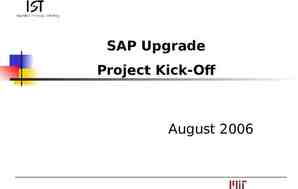Statistical, Economic and Social Research and Training Centre for
27 Slides769.73 KB

Statistical, Economic and Social Research and Training Centre for Islamic Countries Statistical Capacity Building Programme OUTBOUND TOURISM STATISTICS Akhmad Tantowi BPS-Statistics Indonesia Paramaribo, 9 – 11 August 2016

Outline What is outbound tourism? Measuring flow and characteristics of outbound visitors Indonesia Outbound Tourism Statistics

Type of visitors International Domestic country of residence different from country visited Inbound visitors Outbound visitors country of residence the same as country visited

International tourism Inbound tourist Outbound tourist

What is Outbound Tourism? Outbound tourism comprises the activities of a resident visitor outside the country of reference, either as part of an outbound trip or as part of a domestic trip; Outbound visitor is a traveler taking a trip to a country outside his/her usual environment, for less than a year, for any main purpose (business, leisure or other personal purpose) other than to be employed by a resident entity in the country visited.

Classification of outbound travellers Busness & professional Holiday, leisure & recreation outbound Travellers Visiting friends and relatives outbound Visitors Education & training Health & medical care Religion/ pilgrimages Other outbound Travellers Tourists (Overnight Visitors) Same-day visitors (Excursionists) National residing abroad Other nonresidents (foreigners) Main purpose of tourism trip Shopping Transit Other Border workers Other travellers deemed not to enter the economic territory (Diplomats, military, armed forces on maneuver Seasonal workers Other short-term workers Long-term workers long-term students and patients and their family joining them Persons entering the country to establish there their cor Crews on public modes of transport Nomads and refugees Transit pass not entering the eco and legal territory

Relationship between international arrivals and different categories of visitors and other travellers International arrivals Arrining nonresidents Visitors Returning residents Other travellers Visitors Others Other travellers Nomads, refugees Business & prof Border workers Business & prof Border workers Holiday, leisure & rec Crew of public trans Holiday, leisure & rec Crew of public trans Visiting friends & rel Frequend border crossers Visiting friends & rel Frequend border crossers etc etc etc etc

Measuring flow and characteristics of outbound visitors Countries often leave the observation of outbound tourism in general to a later stage, than that for inbound and domestic tourism. This is because its impact on the local economy is felt as a “loss” (an import), since the corresponding economic transactions occur between a resident visitor and a nonresident service provider. However, if, within a tourism promotion policy, national travellers are to be encouraged to select domestic destinations, the reasons for their choice of foreign travel need to be understood

Measuring flow and characteristics of outbound visitors (1) any country setting out to develop a system of data collection on international tourism should first identify all available relevant administrative records. In the case of outbound tourism, the main sources of information will be: – administrative data collected by the border protection authorities; This data identifies all travellers – both visitors and non-visitors – although in some countries very frequent border crossers, e.g. people crossing the border on a daily basis for work purposes, may not be recorded. – special surveys designed to collect supplementary information, at or near the border, or using household survey The survey usually to collect data such as the demographics of the visitors, activities while in the country, places visited, how much spent while in the country, etc.

Measuring flow and characteristics of outbound visitors (2) Beyond NTAs and NSOs, Central Banks, who are usually in charge of compiling and providing BoP data, might also be interested in participating in decisions concerning the frequency with which international tourism flows and expenditure by inbound and outbound visitors are measured they could be valuable partners in the development of tourism statistics.

Statistics of outbound visitors Port of departure – useful for stratification of universe Demography (sex, age, civil status, occupation) Main purpose of the trip – Essential for identifying types of visitors’ trips

Statistics of outbound visitors (1) Mode of transport used Type of accommodation – needs to be confirmed Length of stay – Very useful as initial indication as to actual length of stay; needs to be confirmed Expenditure

Indonesia Outbound Tourism Statistics Officially, BPS/MoT has not released the number of outbound visitors Central Bank has used outbound visitors data in compiling BoP Main source in compiling the flow of outbound visitors arrivals is monthly report of immigration offices throughout Indonesia The data of number of Indonesian working abroad have been obtained from BNP2TKI The expenditure of outbound visitors have been established through questions on the Outbound Survey conducted by MoT

Immigration Reports Immigration offices compile the monthly reports from immigration office branches reports at international port of departure leave Indonesia Indonesia has more than 130 international ports of entry Immigration reports descript the outflow Indonesian and foreigners

BNP2TKI Reports Outbound visitors from immigration report: – Indonesian authority give specific regulation for Indonesian want to work in abroad

Outbound Survey Outbound Survey has been conducted by the Ministry of Tourism BPS has assisted the MoT related methodology and questionnaire Central Bank has been involved in the survey as a user using the data MoT also has coordinated with many institution such as immigration authority and port of entry authorities

Outbound Survey (1) Outbound Survey has been conducted by face to face interview Outbound Survey has been conducted in several main port of entries Respondents of each port or country are calculated based on number of Indonesian outbound a year before Respondent criteria: age 15 years, Indonesian, individual trip The survey has been conducted every two years

Questionnaire Outbound Survey

Questionnaire Outbound Survey (1)

Number of Indonesian Outbound, 2011-2015 900000 2011 2013 2015 850000 800000 2012 2014 750000 700000 650000 600000 550000 500000 450000 400000 Jan Feb Mar Apr May Jun Jul Aug Sep Oct Nov Des

Number of Indonesian Outbound by Destination, 2013 vs 2011 0 ASEAN Asia 10 50 60 70 80 12.92 15.60 Oceania 2.89 4.79 Africa 40 62.53 3.68 7.90 America 30 76.79 Europe Middle East 20 2.10 6.22 2011 2013 1.37 2.47 0.26 0.49 % 90

Characteristics of Indonesian Outbound, 2013 Sex 30 Occupation % 20 10 Female 49.97% Male 50.03% 0 h al fe m rs nt ec wi ude sion /Ad the T e / l s t o St es ica Hou en of er m r l e P /C ag la es an S M Main Purpose 60 Age % 40 20 35-44 31.02% 0 re ess nds ICE lth on ers u a ti h s n lei usi frie M He uca Ot / B ng ay Ed lid siti i o V H 25-34 32.47% 45-54 14.61% 55-64 3.90% 64 1.06% 25 16.94%

Average Expenditure and LoS per Visit of Indonesian Outbound, 2010-2013 Average Exp Per Visit Average LoS 1000 9.5 980 9 8.5 Days US 960 940 8 7.5 7 920 6.5 900 6 880 5.5 860 5 2009 2010 2011 2013 2009 2010 2011 2013

THANK YOU TERIMA KASIH MATUR NUWUN

Slide Title Make Effective Presentations Using Awesome Backgrounds Engage your Audience Capture Audience Attention

Slide Title Make Effective Presentations Using Awesome Backgrounds Engage your Audience Capture Audience Attention

Slide Title Product A Feature 1 Feature 2 Feature 3 Product B Feature 1 Feature 2 Feature 3






